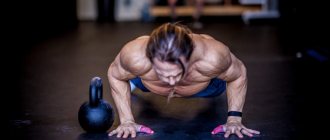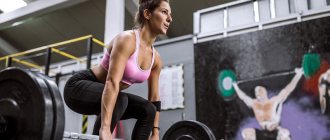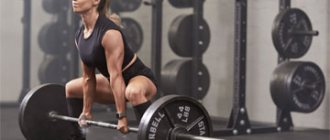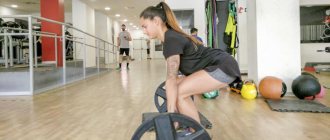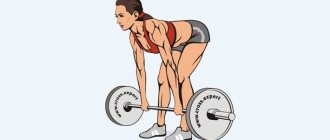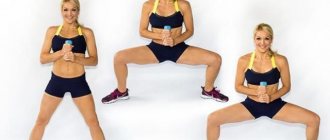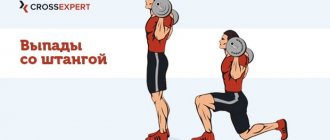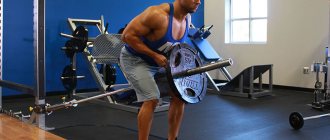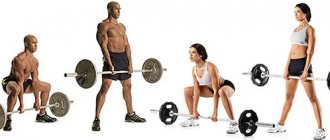Place the bar on the Smith machine at mid-thigh level and grasp the bar with a pronated grip. Raise the bar, keep your torso straight, feet shoulder-width apart. Lower the bar toward your feet, bending at the waist and keeping your back straight. As you exhale, move forward. As you inhale, return to the starting position.
Rules for performing the exercise
- Set the bar on the Smith machine at mid-thigh height. After selecting the correct height and setting the bar, grip the bar with a pronated grip (palms facing forward), palms shoulder-width apart. You may need wrist bands when using heavy weights.
- Raise the bar with your arms fully extended and your back straight. Stand up straight, keep your torso straight, place your feet shoulder-width apart or narrower. Bend your knees slightly. This will be your starting position.
- Keeping your knees stationary, lower the bar toward your feet, bending at the waist and keeping your back straight. As you exhale, continue moving forward as if you were about to pick something up off the floor until you feel a stretch in your hamstrings.
- As you inhale, begin to straighten your torso again as you feel the stretch in your hamstrings, straightening your hips and waist until you return to the starting position.
- Perform this exercise as many times as necessary.
Caution: This exercise is not recommended for people with lower back problems. In addition, you should not round your back forward when moving your torso down; your back should always be straight. Finally, sudden movements or too much weight can lead to back injury.
Variations: a) This exercise can also be performed with dumbbells or a straight bar. b) This exercise is similar to the stiff-legged row, but is performed using a Smith machine.
Alternative Exercises
What to choose - classic or simulator
If your goal is the fastest possible growth in muscle mass and strength, then choose a classic barbell deadlift. It causes a stronger hormonal response and uses more muscles. This means that you will see the results from using this exercise faster.
If you want to use a safer form of deadlift (but less effective in gaining mass), then your choice is the Smith machine deadlift.
By the way, the Smith deadlift is poorly suited for the development of strength indicators. Here the involvement of the muscles that stabilize the body is minimal. And as you know, the growth of strength directly depends on the increase in the power potential of these small links.
Common mistakes
Unfortunately, almost 50% of athletes do this exercise incorrectly. The main mistakes are rounding the upper back . This does not need to be done, since the pressure on the lumbar region increases, and this is fraught with the appearance of an injury that will remind itself for a very long time.
You should not help yourself “push” the weight with your legs . The entire body and legs must remain motionless so that unnecessary movements do not lead to injury. To give greater stability, the feet are placed slightly wider than the shoulders.
Some beginner athletes try to lift heavy weights with their legs fully extended . Due to the heavy load at this moment, not only the knee joints, but the back begin to suffer. The fact is that its upper part is rounded, trying to reduce the load, and this negatively affects the condition of the spine.
Often athletes try to fully straighten their elbow joints by lowering the barbell . In this case, “turning off” the joint is not recommended, since this action will transfer unnecessary load to it, increasing the risk of dislocation.
Its effectiveness depends on how much an athlete knows how to use a gainer.
Find out how to take fat burners from this article: /nutrition/dobavki-nutrition/zhiroszhigateli-v-domashnih-usloviyah.html.
Useful tips
- The slope of the body should always be almost parallel to the floor. It should be 80 degrees, not 50, as many beginners believe. At the same time, the legs bend slightly at the knee joints.
- The movement of the bar must strictly go up and down. Under no circumstances should it “walk” to the sides, as the athlete’s balance may be disrupted. If the stance is done correctly, the bar will always rest against the navel.
- The exercise can be done with both a direct and reverse grip. A reverse grip allows you to better feel your back due to the fact that your elbows are pressed closer to your body.
- It is important not to forget about the movements of the shoulder blades. When lifting the barbell, you need to bring them together as much as possible, straightening your chest forward. As the bar drops, the shoulders drop along with it and a slight roundness begins to form. This is done specifically in order to maximally load the latissimus muscle.
- Some athletes prefer to do this exercise with a curved bar, but this is not necessary. It is important to consider your own convenience.
Deadlift Equipment
The training complex can be performed both with and without equipment. However, the first option is preferable. Equipment means everything that can increase the results of training. This includes:
- straps;
- overalls;
- knee bandages.
I would also like to mention the athletic belt. Although it allows you to lift more weight, first of all it still protects against umbilical hernia and spinal injury. Therefore, it is recommended to wear it even during bare-metal training.
Efficiency
When doing squats on a Hackenschmidt machine, their effectiveness increases due to full concentration on observing the correct technique for performing the exercise. Also, the simulator is designed in such a way that with minor loads on the body, it is possible to qualitatively pump a large number of muscle fibers of the legs and buttocks, while engaging some of the abdominal and back muscles.
You can increase the effectiveness of the simulator by following the basic rules:
- When building muscle mass, use the maximum allowable weight, and if you need to create relief, use the minimum weight.
- The speed of movement on the simulator is slow and without jerking.
- The body is perfectly level and the head, shoulders and buttocks are in contact with the back of the machine at all stages of squats.
- Flexion of the knee joints is carried out only vertically, without moving them apart.
- The location of the foot in classic squats is 20-35 cm in front of the body axis and parallel to each other.
- When performing squats, do not allow your knees to go beyond the toes and your heels to come off the base of the machine.
- Stopping while performing exercises is not allowed. It is necessary to slowly and smoothly complete the full number of repetitions included in one set.
By following the basic rules, increasing the effectiveness of training on the Hackenschmidt simulator will not be difficult. An integrated approach to the formation of a sports body, including the main components of successful training such as proper nutrition, adequate sleep, vitaminization of the body and a systematic training process will speed up the process of creating powerful legs.
Safety
This type of traction is completely contraindicated for people who have had a spinal injury in the past. Too much weight on the barbell can cause spinal discs to become displaced, causing an old injury to reopen.
To protect your lower back from dangerous sprains, you shouldn't be a hero with too much weight. Beginners can practice the exercises by training with an empty bar. This is much safer than loading an unprepared back with heavy weight.
To ensure additional safety for the spine, it is important to completely eliminate jerking movements . Any jerk, especially if it is performed with a large weight, instantly overloads the ligaments, and in untrained people they can easily tear or stretch.
Alternative Deadlift Exercises
The deadlift can be replaced with other exercises only if there are medical contraindications to this training. An alternative would be:
- pull-ups on the bar;
- hyperextension;
- reverse hyperextensions;
- abduction and extension of the lower limbs in the simulator.
In conclusion, I would like to add that this movement is not recommended to be done often (no more than 3 times a week). If you use too little weight to avoid damage, then the exercise will be of no use.
Principle
When performing this exercise, you need to lift the barbell off the floor. The movement is conditionally divided into three phases:
- Breakaway.
- Lifting.
- Fixation.
Following the correct technique, the athlete simultaneously squats and pulls the barbell.
For a complete understanding of the correct technique, you can watch a video of the execution on YouTube. For example:
- At com yougifted, http tvoytrener - sites that are easy to train with, since they are a video training system.
- On English-language resources - com youg, http www powerlifting gym, etc. Here, too, everything is clear even without translation into Russian.
What muscles work
The target muscles of the exercise are:
- Spinal extensor muscles.
- Trapezius muscles.
- Quadriceps.
- Thigh biceps.
- Large glutes.
The accessory muscles are:
- Adductor muscles of the thigh.
- Deltoid muscles.
- Gluteus minimus and medius.
- Tibialis anterior muscle.
- As well as the abdominal muscles, however, they work with less load by fixing the direction of movement of the load.
Why do deadlifts
Correct execution of deadlift:
- Works several large muscle groups, many small bundles (approximately 70% of the muscles throughout the body are involved). This exercise becomes basic for every bodybuilder.
- Helps increase muscle mass and increase strength.
- Acceptable for some back pathologies.
The classic deadlift and its other types have not only a functional purpose. They expend a lot of energy, allowing them to lose excess weight in the form of body fat.
Inclusion in the training program
In most cases, Smith deadlifts are performed to improve the definition of the back muscles.
Thanks to the design of the simulator, you can not be distracted by maintaining balance and direct all your attention and energy to working the target muscles.
During relief work, deadlifts are placed in the middle or end of the program on the back. The weight used is light or medium, the repetition range is 15-20 times per approach. The pace of movement is slow and controlled.
During the mass-gaining period, traction in the Smith machine can also be used depending on the situation. This includes, for example, the inability to do the classic deadlift with a barbell due to a minor injury. But in Smith, as a rule, deadlifts are performed quite comfortably even with such moments.
Another option is for beginners who are just starting to master this exercise.
The Smith deadlift technique is learned much faster and easier than with a barbell. Here they also use light and medium weights, in the repetition range - 8-10 times per approach.
Beginners should not rush things and quickly move on to heavy weights. For them, the main thing is to master the correct technique and form an ideal motor skill. And this goal can only be achieved by training with light to medium weights.
Girls often enjoy doing deadlifts in Smith both during the mass-gaining period and when training for relief. True, they give more preference to the Romanian deadlift, aimed at developing the gluteal muscles and hamstrings.
Features and advantages of the Smith machine
- The stable position of the bar in the structure allows you to perform exercises without insurance. The ability to install restraints that will not allow the athlete to be crushed by the barbell makes the simulator safe.
- Due to the design features, most exercises involve fewer stabilizer muscles, which results in less effort and allows you to focus on the target muscles. This is especially convenient for beginners or, for example, girls who want not to overload the quadriceps and back when squats, but to get an emphasis on the gluteal muscles.
- The stable position of the bar allows you to focus on technique due to the stability of the bar, which does not roll from side to side, as happens with free weights. Just like the limiters, this allows you to work with a large working weight.
Recommendations
- The spine is stable, it is better not to make movements in the hip joints, removing the buttocks from the path of movement of the bar. It is recommended to slightly bend forward to make the movement more uniform and smooth;
- It is better to pull the Haney row to the upper part of the lower back, that is, in the deepest possible amplitude, and at the same time control the position of the body so as to avoid helping yourself by changing the angle of the spine;
- At the extreme point of amplitude, the elbows should look up, and the angle of flexion at the joint should be acute;
- To perform this deadlift correctly, you need good muscle awareness. Ideally, the movement begins at the shoulder joint and is initiated by the rear deltoid, with the elbows then bending. Those who bend their elbows first transfer some of the load to the biceps;
- It is also not allowed to work at the expense of the wrists; it is better not to bend them too much, because this shifts the emphasis to the forearms.
Peculiarities
The classic deadlift is a challenging exercise from a technical standpoint. Since it is basic, it involves the involvement of a large number of joints. When performing a movement using free weights, barbells or dumbbells, inexperienced athletes increase the risk of injury, since the work involves many muscles, including stabilizing ones, which may lag behind the main ones and cannot withstand the load. In addition, as already mentioned, due to incorrect execution technique, an athlete can reduce the effectiveness of this excellent exercise.
Sumo style technique
The sumo technique involves wide stance of the feet. The design of the Smith machine cannot always provide such an opportunity; naturally, this applies to tall athletes. The sumo version emphasizes the load on the inner thigh. The technique is identical to the classic one, with the exception of the positioning of the legs. The feet in this exercise are turned to the sides. The squat is as deep as possible. It is this version of the deadlift that is very relevant for girls. Of course, it is also beneficial for men, as it provides a good load on the hips.
How to do bent-over barbell rows correctly?
The bent-over barbell row cannot be called a simple exercise. Like any multi-joint movement, it has its own rules and nuances of execution. Tips on the technique for performing it are as follows:
Use wrist straps
Some bodybuilders do not remove them, others do not recognize them at all. As they say, it's a matter of taste. But you should understand that we hold the barbell with our hands, so the small muscles of the wrists will get tired before the large latissimus muscles, and simply will not allow us to fully load the back. Yes, your forearms will grow, but the muscle mass of your back will remain in place. If this situation does not suit you, perform bent-over barbell rows only with the help of wrist straps.
Don't arch your back
Rounding the back is the main mistake of all inexperienced athletes who want to build up their back faster. And at the same time - a well-trodden road to the doctor's office. A power belt will partially minimize the risk of lower back injuries, but proper technique for performing bent-over rows solves the problem with a guarantee. In all basic back exercises without exception, it should be arched and the pelvis should be moved forward. This makes it easier to contract the back muscles, and the load on the spine will be lower.
Use a medium grip
In bent-over barbell rows, designed to develop the lats rather than the shoulder girdle, the grip width should be medium, at shoulder level. Increasing the grip width slightly shifts the load to the outer areas of the lats, but significantly reduces the trajectory of movement. A narrow grip in such exercises is generally meaningless; it only overloads the wrist joints.
Change rep range
Our muscles do not have a program that triggers the growth of muscle mass after 8 or 10 repetitions. When performing any exercise aimed at muscle growth, the time spent under load is much more important than the weight of the barbell and the number of approaches. If you can’t pump up your lats by doing the usual 10 reps, reduce the weight of the bar and do 15 or even 20 reps.
Can't pump up your back? Vary your rep range
We are all different, some (athletes whose muscles are dominated by white muscle fibers) are suited to a power style of back pumping, while others (those with a predominance of red muscle fibers) are suited to a volumetric style. Vary the rep range each session to activate both types of muscle fibers and significantly speed up your back mass gain.
TOP 2 | Reverse grip barbell row
The authorship of this exercise belongs to a real mass monster, Dorian Yates himself, the great champion and 6-time Mr. Olympia. His lats are still considered one of the best in the history of bodybuilding, essentially being the standard for a wide and powerful rear. At the same time, his back training program was very modest - pull-ups, deadlifts, and of course, bent-over barbell rows. Sometimes it was the classic version, but most often Yates pumped his lats with a reverse-grip barbell row.
Bent-over barbell row with a reverse grip. Performed by the author
The only visible difference between this deadlift and the usual version is only in the grip of the barbell. But this small detail allows you to move your arms behind your back a little further and contract your back muscles more strongly. In this case, the load shifts from the middle of the lats to their lower segment. The rules for performing barbell rows with a reverse grip are as follows:
- The tilt of the body should be below 45°. Then the load on the latissimus muscles will be higher
- You need to pull not with your hands, but with your back. The biceps must be relaxed and the barbell must be pulled using the efforts of the spinal muscles.
- At the point of maximum tension of the lats, you need to pause and additionally bring your shoulder blades together
